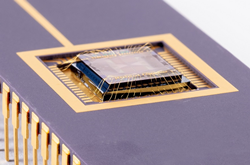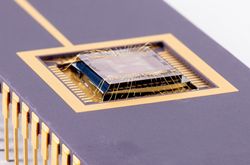
Draper’s new LiDAR with MEMS beamsteering technology is designed to enable self-driving cars to see at greater distances.
“At Draper, we have experience with differing beamsteering methods, such as optical phased arrays. However, we feel MEMS optical switches provide an elegant simplicity,” said Sabrina Mansur, Draper’s self-driving vehicle program manager.
CAMBRIDGE, Mass. (PRWEB)
December 12, 2019
LiDAR, short for light detection and ranging, is often considered the primary sensor for self-driving cars, given its ability to create high definition maps of the surrounding environment. LiDAR provides a three-dimensional point cloud of a car’s surroundings by measuring how long light takes to travel to an object and bounce back.
Currently, most LiDAR systems rely on mechanical scanning, which suffers from poor reliability and high cost. In contrast, Draper has developed, and recently advanced, a LiDAR-on-a-Chip that uses patented, all-digital MEMS optical switches for beamsteering.
Draper’s all-digital switches provide robustness for the harsh automotive environment, which carries advantages over competing solid-state approaches that rely on analog beamsteering. In addition, the use of novel components, like optical switches, MEMS and integrated photonics, all on a single-chip, allows Draper to surpass current LiDARs in range and resolution.
The result is that Draper has successfully built a high resolution solid state LiDAR that images objects at 50 meters. In the development of this achievement, Draper demonstrated low-loss waveguides with verified losses under one dB/cm and MEMS optical switches with lifetimes surpassing 10 billion cycles.
With Draper’s LiDAR, light is emitted through a matrix of optical switches and collected through the same optical switches, which allows for a favorable signal-to-noise ratio, since little ambient light is collected.
Draper’s LiDAR is being developed to image a range of hundreds of meters while providing a corresponding angular resolution targeted at less than 0.1-degrees, a significant advancement over competing LiDAR systems, many of which offer lower range and resolution.
“At Draper, we have experience with differing beamsteering methods, such as optical phased arrays. However, we feel MEMS optical switches provide an elegant simplicity,” said Sabrina Mansur, Draper’s self-driving vehicle program manager. “If we want to image a target at a specified location, we simply enable the corresponding optical switch, whereas other approaches rely on precise analog steering, which is challenging given automotive’s thermal and vibration environment.”
The new offering, which is available to license, adds to Draper’s growing portfolio of autonomous system and self-driving car capabilities. The portfolio includes the Draper APEX Gyroscope—a MEMS gyroscope that provides centimeter-level localization accuracy, and Draper’s all-weather LiDAR technology, named Hemera, a detection capability that’s designed to see through dense fog and is compatible with most LiDAR systems.
Draper
At Draper, we believe exciting things happen when new capabilities are imagined and created. Whether formulating a concept and developing each component to achieve a field-ready prototype or combining existing technologies in new ways, Draper engineers apply multidisciplinary approaches that deliver new capabilities to customers. As a not-for-profit engineering innovation company, Draper focuses on the design, development and deployment of advanced technological solutions for the world’s most challenging and important problems. We provide engineering solutions directly to government, industry and academia; work on teams as prime contractor or subcontractor; and participate as a collaborator in consortia. We provide unbiased assessments of technology or systems designed or recommended by other organizations—custom designed, as well as commercial-off-the-shelf.
Share article on social media or email:

